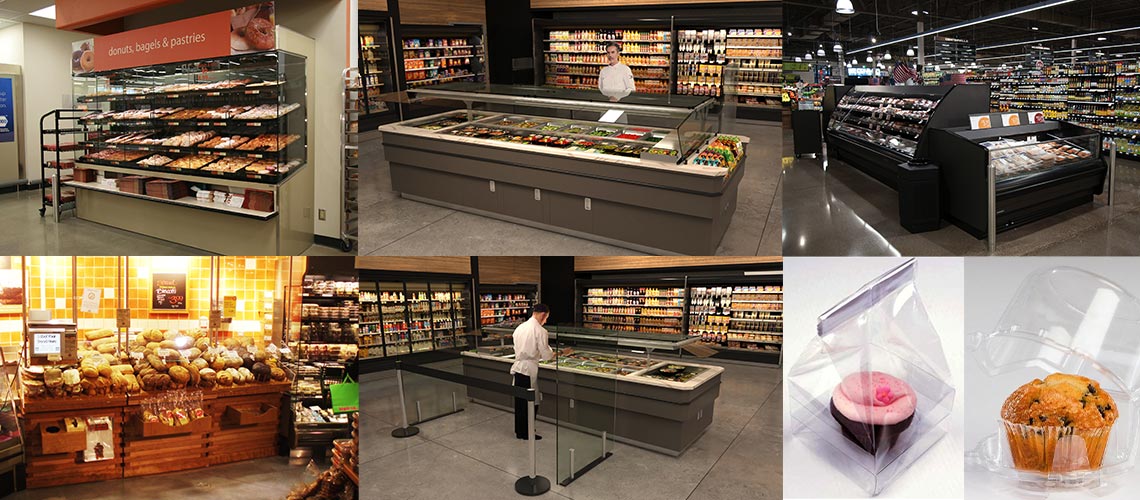Merchandising Tips for Food Retail Amid COVID-19

The beginning of 2020 has been an eventful one, to say the least. The world has been turned upside down as a result of the COVID-19 pandemic, and grocery stores have been designated as essential businesses supplying the necessary resources to feed and provide for their customers. As a result, businesses are also needing to rethink their store layout and merchandising strategy.
Supermarkets need to shift the dynamic of the way they have always done business. They are now reimagining their merchandising strategy, and how they can effectively use their existing equipment to accommodate the needs of today and offer flexibility for the future.
Food Bars
Because of the Coronavirus, a number of safety measures will have to be put in place in order for the public to feel comfortable getting items from food bars. So, how do you resolve to utilize your existing equipment in the meantime? Here are a few ways to reimagine them:
- Remove pans and divider bars from refrigerated sections on a food bar. This allows maximizing pack-out for prepackaged products to be merchandised on the deck pan within the refrigerated well. Utilize this space to provide prepackaged single-serve items or 2-ounce cups and market it as a “Grab-and-Go” station for quick lunch or dinner items.
- Convert refrigerated food bars into DIY Prepared Meals Station. Many customers are cooking from home since many restaurants are still closed or are only offering curbside pickup. Why not offer items like packaged cut produce, premeasured sauces in mason jars or small containers and recipes for them to follow.
- Provide pass-through chute on a shop-around food bar. A double-sided food bar can still be utilized effectively with one side designated as a service side and the other with prepackaged foods such as salads in a clamshell container. Also, consider a portable wash station positioned in the service area for employees working the bar in this fashion. You must rope off or put a barrier up to keep customers from entering the service area.
- Convert hot wells to a prepackaged, self-service application. Simply add prepackaged product into the hot food well, or add a hot tile over each of the pan openings. It is important to load products into the hot case as quickly as possible and frequently monitor temperatures to be sure that the items are holding your local health department’s recommended hot foods temperature. You can also look at utilizing time as a means of control to assure required compliance.
- Turn a single-sided food bar with an open back panel into a service food bar. Add a portable, vertical sneeze-guard on the shopper side of the bar to close off self-service access.
Service and Self Service Cases
- Store personnel should disinfect the front glass to keep it sanitary. Post signs asking shoppers not to touch the case glass while waiting or being helped.
- Have utensils such as straws, lids, cups, etc. placed in a service area and made available upon request. This will help alleviate additional unnecessary touchpoints.
- Install an L- or U-shaped plastic barrier in front of the scales to protect the food when weighing.
- Modify a self-service crusty bread case by installing a vertical sneeze guard transforming it into a service case, or put your fresh-baked bread in paper or plastic bags and merchandise.
- Modify a self-service pastry/donut case by merchandising your pastries and cupcakes in clamshell packaging, paper bags with clear windows, or plastic bags so they are protected and easily identified. This will still engage the shopper and entice them to purchase, while still protecting items. If the pastry case has rear-access doors, it can be modified by locking the front and converting it to a service merchandiser.
In addition to adding these potential modifications to existing equipment and to following all local government guidelines and regulations, putting safety and sanitary measures in place such as portable washing stations, sanitary wipes, face masks, and disposable gloves spread throughout multiple areas of the store offer an extra level of security and comfort.
While this pandemic has required many retailers to pivot and alter their operations, one thing is for sure, grocery shopping as we know it will be forever changed.